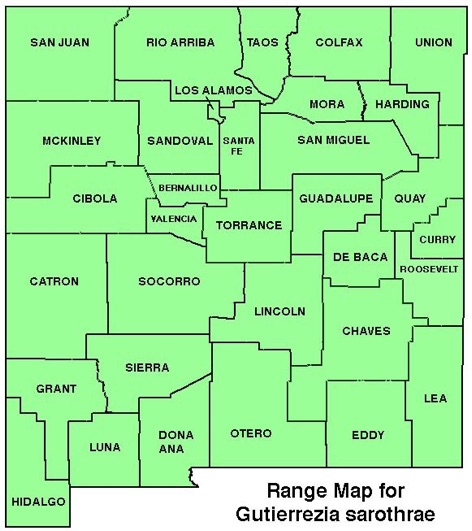WILDFLOWERS OF NEW MEXICO

A blanket of tiny, yellow flowers turn this densely-branching, 1–2-foot tall, rounded plant into a butterball of summer–fall color. This rangy plant is an example of adaptation to harsh, arid habitats. It’s a popular fast-growing addition for fall color in water-wise landscapes. The common names come from traditional uses as a snakebite remedy and as a broom.
FLOWER: July–November. Compact, flat-topped clusters of 2–5 flower heads almost obscure the bright-green foliage. Flower heads have 3–8 small, petal-like ray flowers 1/8–1/4-inch (3–5.4 mm) long, around a yellow center with 3–9 tiny disk flowers.
LEAVES: Alternate. Resinous, bright-green, thread-like leaves are only 1/16-inch (2 mm) wide, 3/16–2 3/4-inches (5–70 mm) long.
HABITAT: Dry, open, sandy, rocky soils, disturbed areas; desert grasslands and scrub, sagebrush, pinyon-juniper, oak-ponderosa communities.
ELEVATION: 3,200–8,500 feet.
RANGE: Widespread and common across western U. S.
SIMILAR SPECIES: 5 look-alike species in NM. The nearly identical Thread-leaf Snakeweed, G. macrocephala, in pinyon-juniper vegetation, has flower heads with only 1 ray flower and 1 disk flower. The widespread annuals, Texas Snakeweed, G. texana (smooth stems), and Roundleaf Snakeweed, G. sphaerocephala (rough stems), are open, airy plants not densely covered with blooms and have narrow leaves with 1 nerve. The open-branching annual Wright’s Snakeweed, G. wrightii, in the southern half of NM, has flower heads with 8–19 yellow rays and narrow leaves with 3–5 nerves.
NM COUNTIES: Widespread and common statewide in low- to mid-elevation, arid habitats.









BROOM SNAKEWEED
GUTIERREZIA SAROTHRAE
Aster Family, Asteraceae
Perennial sub-shrub









THE CONTENTS OF THIS WEBSITE ARE COPYRIGHTED AND CANNOT BE USED
WITHOUT PERMISSION OF GEORGE OXFORD MILLER




















































EMAIL ME







